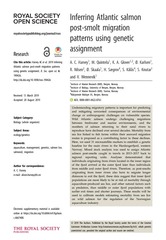| dc.contributor.author | Harvey, Alison C. | |
| dc.contributor.author | Sanchez, Maria Quintela | |
| dc.contributor.author | Glover, Kevin | |
| dc.contributor.author | Karlsen, Ørjan | |
| dc.contributor.author | Nilsen, Rune | |
| dc.contributor.author | Skaala, Øystein | |
| dc.contributor.author | Sægrov, Harald | |
| dc.contributor.author | Kolås, Steinar | |
| dc.contributor.author | Knutar, Sofie | |
| dc.contributor.author | Wennevik, Vidar | |
| dc.date.accessioned | 2020-08-11T13:29:52Z | |
| dc.date.available | 2020-08-11T13:29:52Z | |
| dc.date.issued | 2019 | |
| dc.Published | Harvey AC, Sanchez MQ, Glover KA, Karlsen ØK, Nilsen R, Skaala Ø, Sægrov H, Kolås S, Knutar, Wennevik V. Inferring Atlantic salmon post-smolt migration patterns using genetic assignment. Royal Society Open Science. 2019;6(10):190426 | eng |
| dc.identifier.issn | 2054-5703 | en_US |
| dc.identifier.uri | https://hdl.handle.net/1956/23661 | |
| dc.description.abstract | Understanding migratory patterns is important for predicting and mitigating unwanted consequences of environmental change or anthropogenic challenges on vulnerable species. Wild Atlantic salmon undergo challenging migrations between freshwater and marine environments, and the numbers of salmon returning to their natal rivers to reproduce have declined over several decades. Mortality from sea lice linked to fish farms within their seaward migration routes is proposed as a contributing factor to these declines. Here, we used 31 microsatellite markers to establish a genetic baseline for the main rivers in the Hardangerfjord, western Norway. Mixed stock analysis was used to assign Atlantic salmon post-smolts caught in trawls in 2013–2017 back to regional reporting units. Analyses demonstrated that individuals originating from rivers located in the inner region of the fjord arrived at the outer fjord later than individuals from middle and outer fjord rivers. Therefore, as post-smolts originating from inner rivers also have to migrate longer distances to exit the fjord, these data suggest that inner fjord populations are more likely to be at risk of mortality through aquaculture-produced sea lice, and other natural factors such as predation, than middle or outer fjord populations with earlier exit times and shorter journeys. These results will be used to calibrate models estimating mortality from sea lice on wild salmon for the regulation of the Norwegian aquaculture industry. | en_US |
| dc.language.iso | eng | eng |
| dc.publisher | The Royal Society Publishing | en_US |
| dc.rights | Attribution CC BY | eng |
| dc.rights.uri | http://creativecommons.org/licenses/by/4.0/ | eng |
| dc.title | Inferring Atlantic salmon post-smolt migration patterns using genetic assignment | en_US |
| dc.type | Peer reviewed | |
| dc.type | Journal article | |
| dc.date.updated | 2020-01-21T14:29:33Z | |
| dc.description.version | publishedVersion | en_US |
| dc.rights.holder | Copyright 2019 The Authors | en_US |
| dc.identifier.doi | https://doi.org/10.1098/rsos.190426 | |
| dc.identifier.cristin | 1760804 | |
| dc.source.journal | Royal Society Open Science | |

